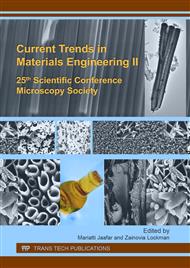p.1
p.5
p.9
p.13
p.17
p.21
p.25
p.29
Influence of Catalyst in Synthesizing Brookite Thin Film Coating
Abstract:
Brookite is the least known titanium dioxide (TiO2) crystallographic phases compare to anatase and rutile. In a sol-gel process, very few works are devoted on synthesizing pure brookite as a thin film coating and usually brookite co-exist with anatase and rutile as a byproduct. This study is performed as an attempt to produce brookite thin film coating via sol-gel dipping method. In this study, the influence of catalyst type on TiO2 phases, morphology and grain size were investigated. Hydrochloric acid (HCl) is used for an acid catalyst and sodium hydroxide (NaOH) is used as base catalyst. All of the TiO2 films were deposited on a glass substrate and heated at four different temperatures of 400°C, 450°C, 500°C and 550°C for 3 hours. X-ray diffraction (XRD) is employed to analyze the phases and the grain size acquired. Images on the surface morphology are obtained with Scanning Electron Microscope (SEM). Results showed that brookite phase exist only for base catalyst with a grain size of 27.40 nm for all of the selected temperatures except at 550°C. SEM results revealed that the surface morphology of the deposited TiO2 film with base catalyst comprised of agglomerated particle networks. In contrast, the surface morphology of the deposited TiO2 film with acid catalyst seems more compact and uniform with an XRD pattern of amorphous-like characteristic having grain size of less than 3 nm.
Info:
Periodical:
Pages:
5-8
Citation:
Online since:
September 2017
Keywords:
Price:
Сopyright:
© 2017 Trans Tech Publications Ltd. All Rights Reserved
Share:
Citation:


